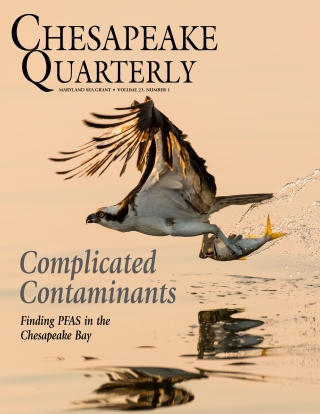Knauss legislative fellowships in Congress help build careers — and they're fun and educational. See our video and fact sheet for details.
Poll Finds Marylanders Trust Scientists on Climate Change
It’s easy for scientists and those who value science to be discouraged by polls on climate change.
A series of surveys have asked Americans, what is the major cause of changing climate conditions? For climate-change scientists, the answer is settled: the overwhelming weight of the available evidence blames human activities, like emissions from autos and power plants, as the primary cause of the global rise in temperatures.
But the poll results indicate that most Americans don't agree. Only about half believe human activities are at fault. A separate survey of Marylanders found a similar result. The survey was released last fall by the Climate Communication Consortium of Maryland and George Mason University in Virginia.
You might be tempted to conclude that the public doesn't take climate scientists seriously and doesn’t think we need to do anything about our contributions to climate change.
But the Maryland poll results contain some promising news for Maryland scientists – indications that they can exert a big influence on public attitudes about climate change and that Marylanders are willing to support action to deal with it.
A survey question listed various types of Maryland leaders and asked the survey respondents whom they trusted most for information on climate change. As a group, scientists at Maryland universities came out tops, at 70 percent. In comparison, only slightly more than 50 percent of respondents trusted environmental organizations and state agencies. The Office of the Governor and the state legislature got lower marks still on this question.
Another finding was that a large majority of the Maryland survey respondents — 77 percent — accepted the idea that the climate is changing. That's a higher percentage than among all Americans, only 64 percent of whom agreed with that idea, according to a 2014 nationwide poll by Yale University researchers.
Perhaps that shouldn't be surprising. In some parts of Maryland, after all, the effects of climate-driven sea level rise are hard to ignore – especially in low lying towns that flood easily and in places like the Blackwater National Wildlife Refuge in Dorchester County where dead, white trees dot the horizon, eloquent evidence of saltwater invasion.
Visible effects like those could explain why eight of 10 respondents in last year’s Maryland survey (conducted before the November election) said that addressing climate change should be a priority for the governor and General Assembly. And why a majority supported almost all of the state's climate and energy policies that focused on reducing greenhouse gas emissions and increasing use of renewable energy.
Taken together, all of these poll results suggest that local scientists have a special opportunity to play a constructive role in helping the state prepare for a changing climate. And a key step may be helping more Marylanders understand why our climate is changing. Last fall’s poll found that only a minority — 37 percent — accepted the scientific consensus that human activities are a major cause. (Other survey respondents who agreed that climate change is occurring blamed human activities and natural forces in equal measure.)
 |
|
Scientists at the University of Maryland studied the genetic diversity of wild celery plants, work that could inform efforts to restore this aquatic vegetation in the Chesapeake Bay. An avenue of research is how the plants will respond to a changing climate. From left: associate professor Maile Neel, Brittany West Marsden, and Hayley Tumas. Credit: Daniel Strain |
Scientists can also help to educate Maryland citizens about other aspects of climate change and the risks they pose to the environment and the economy. Like how rising water temperatures in the Chesapeake Bay may affect a variety of species and how rising sea level may cause increased flooding of homes and properties in vulnerable locations. Maryland’s academic scientists have already contributed to these public discussions by addressing technical aspects – for example, by refining estimates of how much sea level rise might rise.
The public may see scientists as trustworthy on such questions, but that does not give scientists the last word on how to best prepare for the risks posed by a changing climate. These decisions can involve making value judgments, such as how we build our houses near the water’s edge or whether we take public transportation to reduce carbon emissions. Such decisions are for the public and their elected representatives to make. Scientists can inform good decision-making, though, by offering impartial information outside of their regular professional channels – for example, by writing commentaries and book reviews for local newspapers.
Marylanders may not embrace everything scientists have to say. But they are open to listening.
Top photo: Ecologist Bert Drake, of the Smithsonian Environmental Research Center on the Chesapeake Bay, crouches next to one of his team's research pods. The structures are part of a project to gauge the effects on marsh plants of rising carbon dioxide levels in a changing climate. Credit: Smithsonian Environmental Research Center
See all posts from the On the Bay blog






